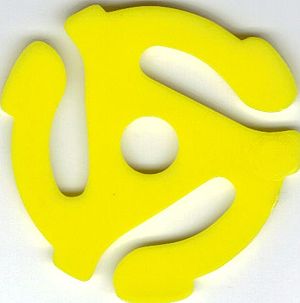SOMEONE CLOSE TO ME JUST ALERTED ME TO THIS GREAT ARTICLE IN THE NY TIMES:
Weaned on CDs, They’re Reaching for Vinyl
___________________________
( I LOVE MY VINYL COLLECTION SINCE A LOT OF THAT MUSIC HAS NEVER BEEN RELEASED ON CD, ONLINE, ETC.
I HAVE ALSO HEARD IN THE RECENT PAST THAT MANY YOUNGER KIDS ARE FINDING VINYL TO BE "COOL" & LIKE WORKING WITH THEM FOR THE CHANGES IN SOUND & INTEGRITY.
LIKE THEY SAY: "EVERYTHING COMES BACK AGAIN"-BUT WHEN ARE CROCS & UGGS GONNA BE GONE ONCE & FOR ALL?)
________________________
By
ALLAN KOZINN MUSIC
MUSIC
"There were always record collectors who disdained the compact disc,
arguing that an LP’s grooves yielded warmth and depth that the CD’s
digital code could not match.
But the market largely ignored them. Record labels shuttered their LP
pressing plants, except for a few that pressed mostly dance music, since
vinyl remained the medium of choice for D. J.s.
As it turned out, that early resistance was not futile, thanks largely
to an audience of record collectors, many born after CDs were introduced
in the 1980s.
These days, every major label and many smaller ones are releasing vinyl,
and most major new releases have a vinyl version, leading to a spate of
new pressing plants.
When the French electronica duo Daft Punk
released “Random Access Memories” in mid-May, 6 percent of its
first-week sales — 19,000 out of 339,000 — were on vinyl, according to
Nielsen SoundScan, which measures music sales.
Other groups with a predominantly college-age audience have had similar
success: the same week, the National sold 7,000 vinyl copies of its
latest album, “Trouble Will Find Me,” and 10,000 Vampire Weekend fans
opted for the LP version of “Modern Vampires of the City.” When the Front Bottoms, a New Jersey indie band, posted a photo of their players carrying stacks of LP mailing boxes on their Facebook page
recently, their label, Bar/None, racked up what Glenn Morrow, who owns
the label, described as “phone orders for $2,000 worth of LPs in 10
minutes.”
There were always record collectors who disdained the compact disc,
arguing that an LP’s grooves yielded warmth and depth that the CD’s
digital code could not match.
But the market largely ignored them. Record labels shuttered their LP
pressing plants, except for a few that pressed mostly dance music, since
vinyl remained the medium of choice for D. J.s.
As it turned out, that early resistance was not futile, thanks largely
to an audience of record collectors, many born after CDs were introduced
in the 1980s. (JOBS????WE NEED THEM!!!)
These days, every major label and many smaller ones are releasing vinyl,
and most major new releases have a vinyl version, leading to a spate of
new pressing plants.(GREAT!!!)
When the French electronica duo Daft Punk
released “Random Access Memories” in mid-May, 6 percent of its
first-week sales — 19,000 out of 339,000 — were on vinyl, according to
Nielsen SoundScan, which measures music sales.
Other groups with a predominantly college-age audience have had similar
success: the same week, the National sold 7,000 vinyl copies of its
latest album, “Trouble Will Find Me,” and 10,000 Vampire Weekend fans
opted for the LP version of “Modern Vampires of the City.” When the Front Bottoms, a New Jersey indie band, posted a photo of their players carrying stacks of LP mailing boxes on their Facebook page
recently, their label, Bar/None, racked up what Glenn Morrow, who owns
the label, described as “phone orders for $2,000 worth of LPs in 10
minutes.”
A growing number of classic albums — including the complete Beatles and early Rolling Stones and Bob Dylan catalogs — have had vinyl reissues in recent years as well.
Michael Fremer, who monitors the LP world on his Web site, Analogplanet.com, said: “None of these companies are pressing records to feel good. They’re doing it because they think they can sell.”
About a dozen pressing plants have sprouted up in the United States,
along with the few that survived from the first vinyl era, and they say
business is so brisk that they are working to capacity. Thomas Bernich, who started Brooklyn Phono in 2000, says his company makes about 440,000 LPs a year, but a giant like Rainbo Records, in Canoga Park, Calif., turns out 6 million to 7.2 million, said Steve Sheldon, its general manager.
One plant, Quality Record Pressings,
in Salina, Kan., opened in 2011 after its owner, Chad Kassem, grew
impatient with delays at a larger plant where his own line of blues
reissues was being pressed. His company, which runs four presses —
acquired used, but modified to run more efficiently — now makes LPs for
all the majors, and lists Jimi Hendrix, Eric Clapton and Nirvana
reissues among its recent projects. He is currently pressing 900,000
vinyl discs a year.
And the buyers, Mr. Bizar said, are by no means boomer nostalgists.
“When you look at the sales for a group like Daft Punk,” he said,
“you’re seeing young kids collecting records like we did when we were
young.”
“We never expected the vinyl resurgence to become as crazy as it is,” he
said. “But it’s come full circle. We get kids calling us up and telling
us why they listen to vinyl, and when we ask them why they don’t listen
to CDs, they say, ‘CDs? My dad listens to CDs — why would I do that?’ ”


No comments:
Post a Comment